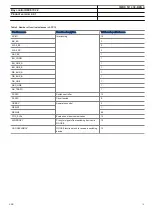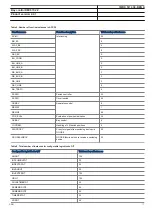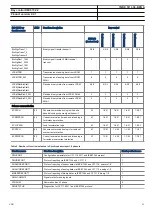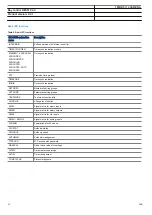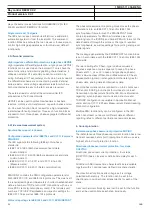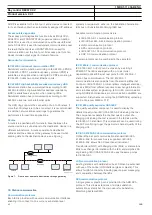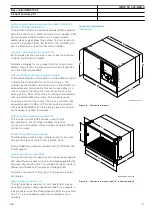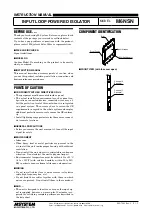
plays the same role as functions GOOSEBINRCV (for IEC
61850) and MULTICMDRCV (for LON).
Single command, 16 signals
M12446-6 v5
The IEDs can receive commands either from a substation
automation system or from the local HMI. The command
function block has outputs that can be used, for example, to
control high voltage apparatuses or for other user defined
functionality.
4. Differential protection
High impedance differential protection, single phase HZPDIF
M13071-3 v13
High impedance differential protection, single phase (HZPDIF)
functions can be used when the involved CT cores have the
same turns ratio and similar magnetizing characteristics. It
utilizes an external CT secondary current summation by
wiring. Actually all CT secondary circuits which are involved in
the differential scheme are connected in parallel. External
series resistor, and a voltage dependent resistor which are
both mounted externally to the IED, are also required.
The external resistor unit shall be ordered under IED
accessories in the Product Guide.
HZPDIF can be used to protect tee-feeders or busbars,
reactors, motors, auto-transformers, capacitor banks and so
on. One such function block is used for a high-impedance
restricted earth fault protection. Three such function blocks
are used to form three-phase, phase-segregated differential
protection.
5. Wide area measurement system
Synchrophasor report, 8 phasors
GUID-7539462D-A3D6-492D-9926-E67C5B7C72D9 v1
Configuration parameters for IEEE1344 and C37.118 protocol
PMUCONF
GUID-33694C62-A109-4D8F-9063-CEFA5D0E78BC v4
The IED supports the following IEEE synchrophasor
standards:
• IEEE 1344-1995 (Both measurements and data
communication)
• IEEE Std C37.118-2005 (Both measurements and data
communication)
• IEEE Std C37.118.1–2011 and C37.118.1a-2014
(Measurements)
• IEEE Std C37.118.2-2011 (Data communication)
PMUCONF contains the PMU configuration parameters for
both IEEE C37.118 and IEEE 1344 protocols. This means all
the required settings and parameters in order to establish and
define a number of TCP and/or UDP connections with one or
more PDC clients (synchrophasor client). This includes port
numbers, TCP/UDP IP addresses, and specific settings for
IEEE C37.118 as well as IEEE 1344 protocols.
Protocol reporting via IEEE 1344 and C37.118 PMUREPORT
GUID-8DF29209-252A-4E51-9F4A-B14B669E71AB v4
The phasor measurement reporting block moves the phasor
calculations into an IEEE C37.118 and/or IEEE 1344
synchrophasor frame format. The PMUREPORT block
contains parameters for PMU performance class and
reporting rate, the IDCODE and Global PMU ID, format of the
data streamed through the protocol, the type of reported
synchrophasors, as well as settings for reporting analog and
digital signals.
The message generated by the PMUREPORT function block
is set in accordance with the IEEE C37.118 and/or IEEE 1344
standards.
There are settings for Phasor type (positive sequence,
negative sequence or zero sequence in case of 3-phase
phasor and L1, L2 or L3 in case of single phase phasor),
PMU's Service class (Protection or Measurement), Phasor
representation (polar or rectangular) and the data types for
phasor data, analog data and frequency data.
Synchrophasor data can be reported to up to 8 clients over
TCP and/or 6 UDP group clients for multicast or unicast
transmission of phasor data from the IED. More information
regarding synchrophasor communication structure and
TCP/UDP configuration is available in Application Manual
under section C37.118 Phasor Measurement Data Streaming
Protocol Configuration.
Multiple PMU functionality can be configured in the IED,
which can stream out same or different data at different
reporting rates or different performance (service) classes.
6. Current protection
Instantaneous phase overcurrent protection PHPIOC
M12910-3 v13
The instantaneous three phase overcurrent function has a low
transient overreach and short tripping time to allow use as a
high set short-circuit protection function.
Directional phase overcurrent protection, four steps
OC4PTOC
M12846-3 v17
Directional phase overcurrent protection, four steps
(OC4PTOC) has an inverse or definite time delay for each
step.
All IEC and ANSI inverse time characteristics are available
together with an optional user defined time characteristic.
The directional function needs voltage as it is voltage
polarized with memory. The function can be set to be
directional or non-directional independently for each of the
steps.
A second harmonic blocking level can be set for the function
and can be used to block each step individually.
1MRK 511 404-BEN A
Bay control REC670 2.2
Product version: 2.2.1
28
ABB


